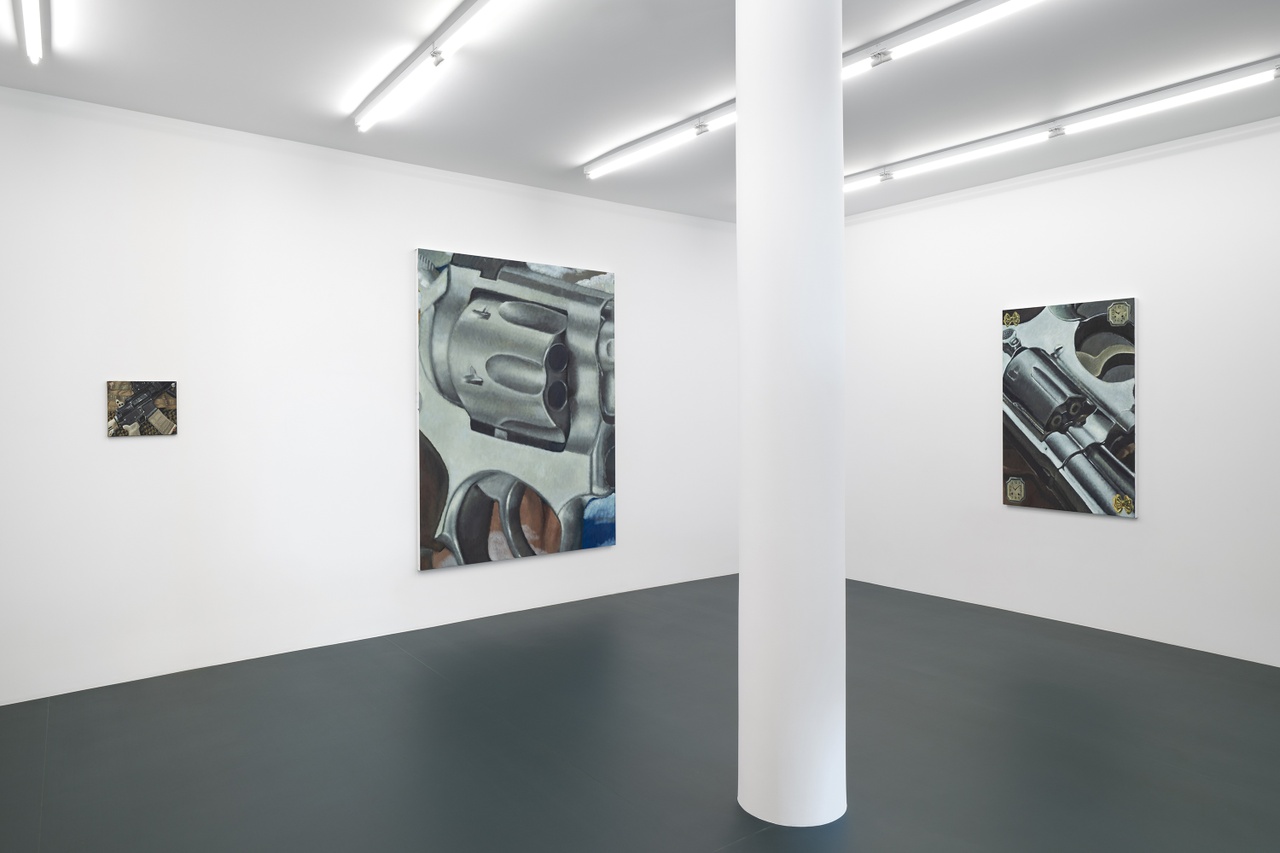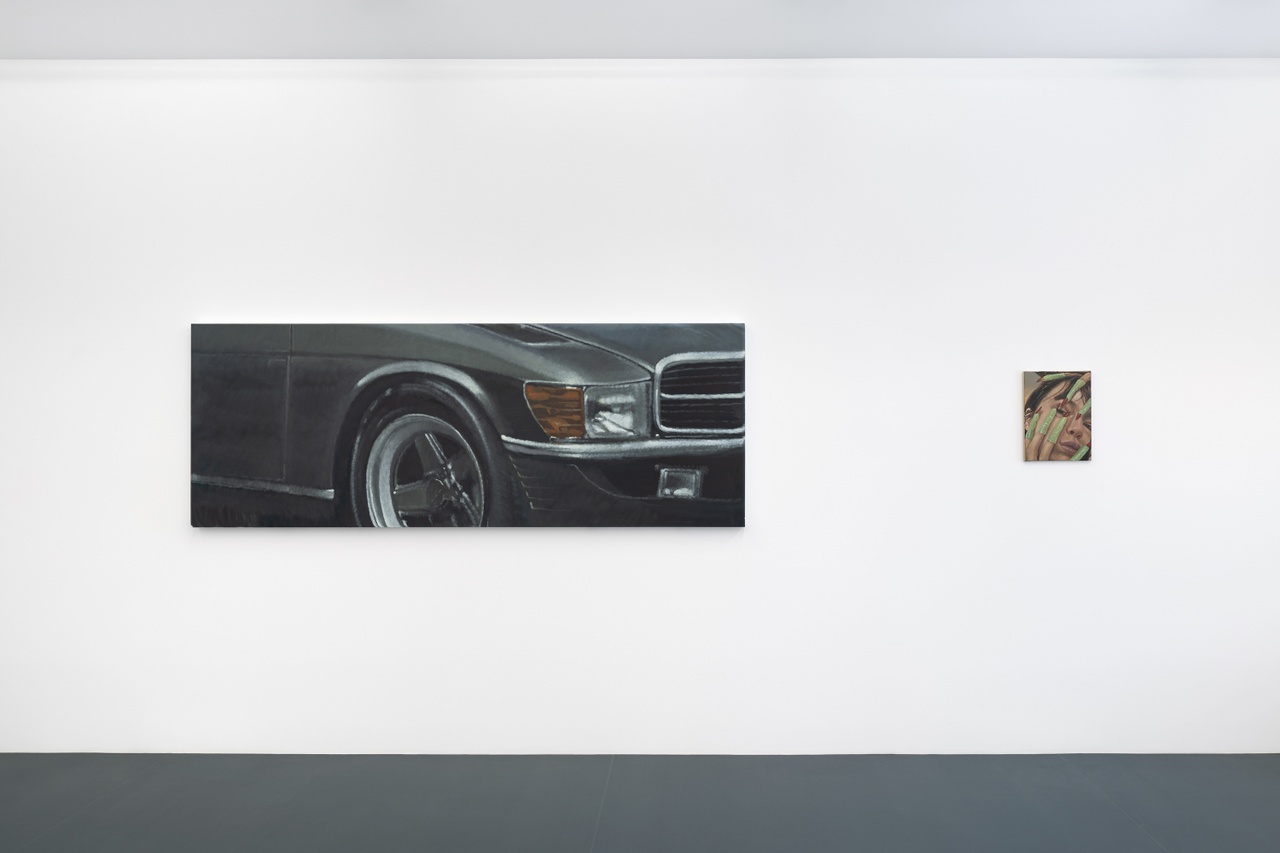MONOTONY OF TYPE Diva Corp on Issy Wood at Michael Werner, Beverly Hills

“Issy Wood: Wet Reckless,” Michael Werner, Beverly Hills, 2025
It’s opening night at Michael Werner for Issy Wood’s “Wet Reckless” show, and as I push through the crowd in the courtyard, I hear an older lady badgering a gallery associate: “Yes, yes, but is she here?” she asks. She’s looking for Issy Wood, “the artist,” she says, and insists on an answer. I slip into the gallery before she gets one.
Once inside, though, I hear it again – Is she here? – this time from a group of twentysomethings. They scan the room. “I hope so,” one of them says. “I just love her music.”
In fact, over the next half hour or so, I hear the query so often that I, too, become invested. Where is Issy Wood? I peer around champagne flutes and purses, through knots of people. I do one lap, then another. I embed outside with the smokers. No sign of her, anywhere.
Not being here is a game Issy Wood is quite good at, and that keeps everybody interested. And she’s not just apparently absent from her own opening. It’s well-documented that Wood doesn’t like to be photographed – a tendency, she suggests, that stems from her experience with eating disorders, with dysmorphia [1] – so almost no photos of her appear online. Her self-portraits – which she began painting to avoid having her picture taken for magazines – are also rare, and invariably portray her face concealed (often by a mask, hands, or glasses). Even her lore is filled with themes of refusal and dropping out, most notably the fact that she rebuffed deals with mega-industry men like Larry Gagosian and Mark Ronson.
Though the intent might be otherwise, Wood’s absence – consistent and noisy and comprehensive as it is – makes us think about her presence far more than her presence would. It heightens our intrigue about who exactly Issy Wood is. It puts the spotlight on her.

“Issy Wood: Wet Reckless,” Michael Werner, Beverly Hills, 2025
Now, at first glance, Wood’s work isn’t all about herself, per se. Apart from a couple of self-portraits, in “Wet Reckless” she paints classic firearms, vintage automobiles, and timeless fur coats, among other things, all in her cold, detached, fuzzy-realistic style. Disembodied as they are, and stripped of their context, the objects she depicts – their craftsmanship, their material, their vanity, their violence – become the immediate locus of consideration. They’re frozen and still, to be examined and re-examined, even desired or loathed, purely based on their singular aesthetic charge.
However, taken with time, what becomes increasingly loud is not the connotation of Wood’s subjects (with repetition, they drift from sensational to mundane) or their representative style (it recedes into an innocuous strand of realism), but, rather, the tyranny of her crop. Again and again in these paintings, Wood’s choice to limit our understanding – to withhold context from her compositions – is the device she leans on to command our attention. Sounds ominous study (2024), for example, isolates the cylinder of a revolver tight and up-close, leaving what seems to be a hand out of focus and in the background; Wet and reckless (2024), a painting of an automobile, crops out everything above and below the fender, namely the driver and the road; and And here’s how (2024) does more of the same, filling the frame with a crimson jacket and leveling things off precisely when we’d see evidence (or not) of a head and hands.

“Issy Wood: Wet Reckless,” Michael Werner, Beverly Hills, 2025
The question Wood’s crop makes us ask is one of ownership. Whose gun is it? Whose car? Whose jacket? Like blinders on a horse, her tight frame directs our gaze and limits its freedom to wander. It also spurs a sense of creeping anxiety and claustrophobia (the approach, after all, is notorious in horror films), thus acting as a mechanism of control over the viewer. It’s a strategy that closes the work to misinterpretation, yes, but also to discovery, and to agency. Hence: tyranny.
And then we have the self-portraits. These, Wood maintains, are not for sale. Again: withheld. If you didn’t get it already – from her refusal to be photographed, to her elusiveness at the opening, to her aversion to industry bigwigs – this is about as nail-on-the-head as it gets. Loud and clear, for the people in the back: Issy Wood cannot be bought. She is in control.
While the gesture could be read as the artist going on strike, or preserving the sanctity of her image, or even tipping the scales of power in her direction – especially at a time when one’s likeness, identity, and body are increasingly exploited for capital and political gain – such a read would be generous. Michael Werner (a prestigious commercial art gallery) in Beverly Hills (LA’s money capital) is not a site of rebellion, no matter how small or rhetorical.
What’s more, by withholding her self-portraits from the market supply, Wood actually increases their desirability and value, and, in turn, further objectifies her likeness. If she’s just playing the game of ownership, this is a shrewd move, somewhat akin to a musician owning their master recordings (or at least the hits). Should her career continue to ascend as it has, one day she’ll be able to clear a considerable sum on her self-portraits at auction and keep every last dime. However, if she intends to “resist” – which her work and interviews seem to indicate she does – it’s worth noting that her gesture will refashion itself as a sales tactic, eventually, as an anecdote used to imbue her work with (token) defiance and the always en vogue “attitude.” Put simply: Michael Werner’s going to sell Issy Wood one way or another.
“Issy Wood: Wet Reckless,” Michael Werner, Beverly Hills, February 15–May 17, 2025.
Diva Corp is an art criticism project based in Los Angeles.
Image credit: Courtesy of the artist and Michael Werner
Notes
| [1] | “Don’t Make Your Hobbies into Jobs!,” Blackbird Spyplane, August 22, 2022. |

